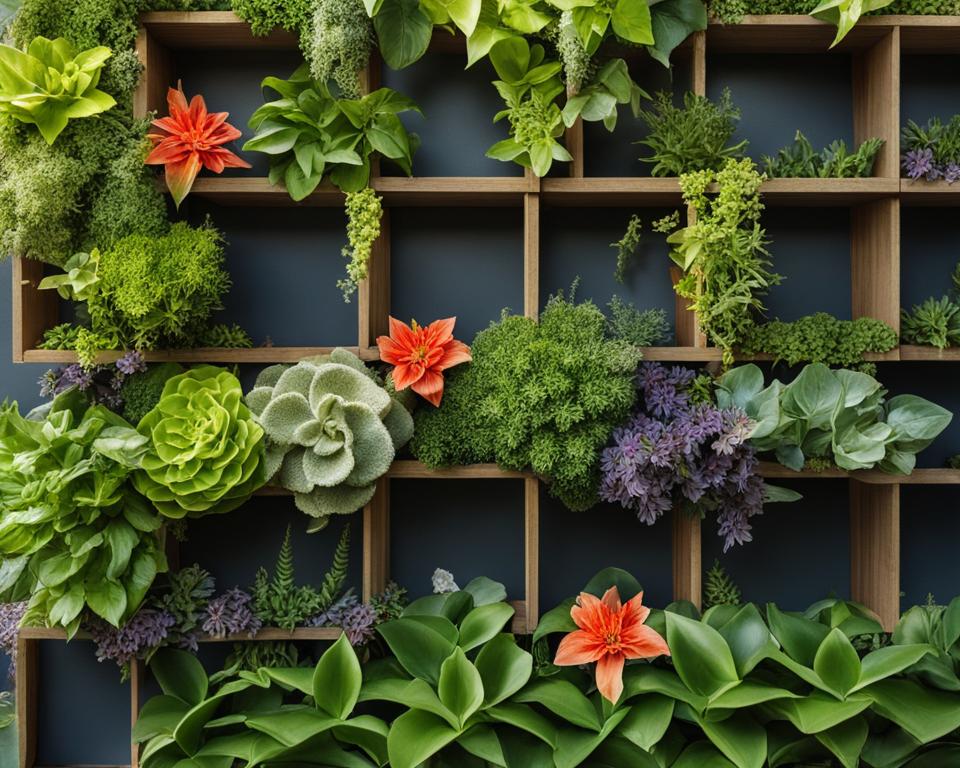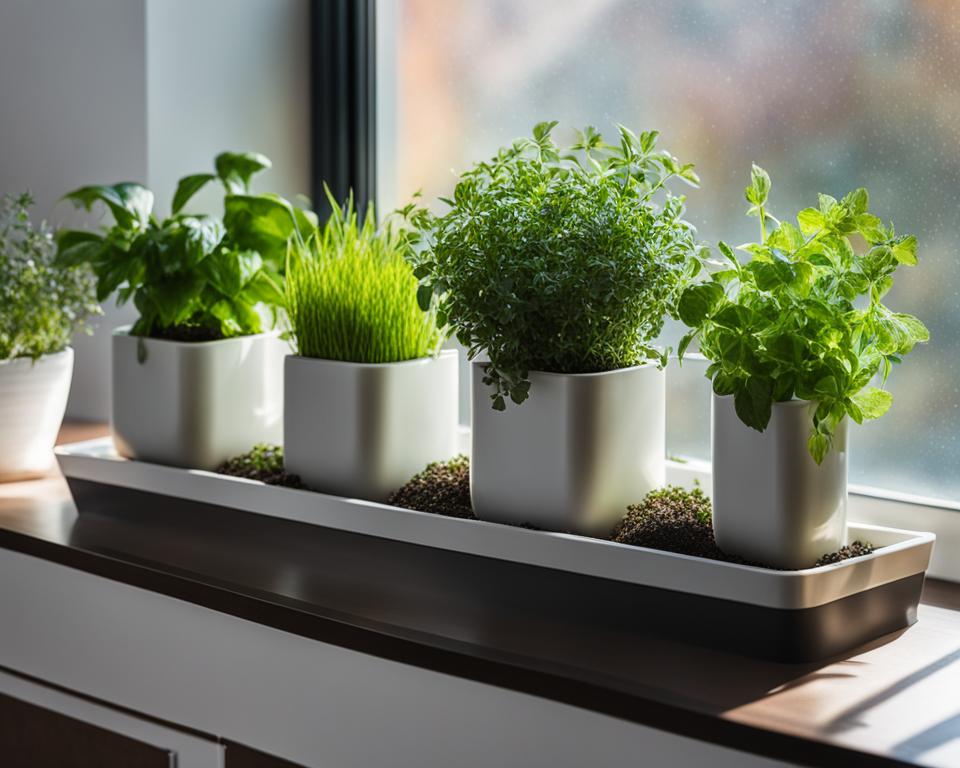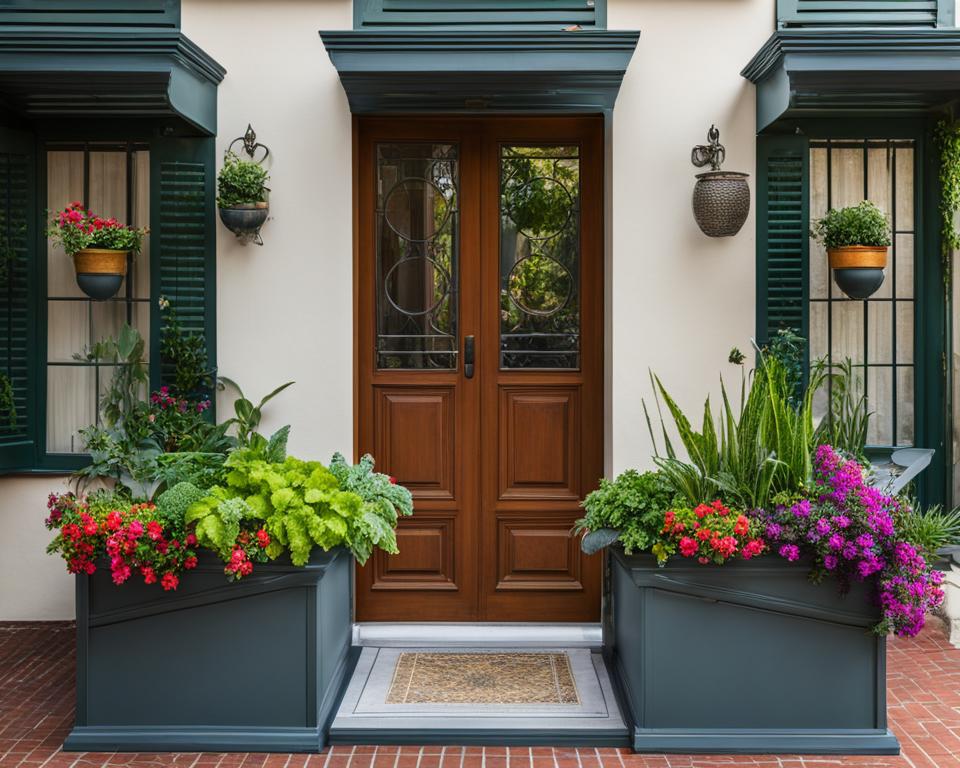Are you ready to bring life and greenery to your urban space? With the help of urban gardening planters, you can transform even the smallest balcony or rooftop into a thriving garden. Whether you’re a seasoned gardener or just starting out, these planters are the perfect solution for creating an urban oasis.
Urban gardening planters come in a variety of shapes and sizes, from compact containers to spacious planter boxes. They are designed specifically for urban gardeners who want to make the most of limited space. With these planters, you can grow all sorts of plants, from herbs and vegetables to colorful flowers, right in the heart of the city.
Key Takeaways:
- Urban gardening planters are essential for creating a thriving garden in small urban spaces.
- They come in a variety of shapes and sizes, including containers and planter boxes.
- These planters allow you to grow a wide range of plants, from herbs to flowers.
- They are designed to maximize limited space and bring greenery to the city.
- Transform your urban space and experience the joy of gardening with these planters.
Create a Community Garden
Looking to create a sense of community while enjoying the benefits of gardening? Consider starting a community garden in your neighborhood. Community gardens are shared outdoor spaces where multiple individuals can come together to plant vegetables, flowers, and herbs. Not only do these gardens bring fresh, locally-grown food to urban areas, but they also foster a sense of camaraderie and teamwork among participants.
Before starting a community garden, it’s important to familiarize yourself with the guidelines and rules specific to your neighborhood or building. Some communities may have specific requirements for garden design and maintenance. Once you have the green light, create a garden design that allows ample space for multiple gardeners to collaborate and work together.
Community gardens provide an opportunity for individuals of all ages and backgrounds to connect with nature, learn about gardening, and share their knowledge with one another. It’s a wonderful way to bring people together and create a thriving green space in your community.
To get started, gather gardening supplies such as tools, seeds, and soil. Consider reaching out to local gardening clubs or nurseries for advice on the best plants to cultivate in your community garden. Encourage participants to contribute their own unique ideas and expertise to make the garden a true reflection of the community.
Benefits of a Community Garden
- Provides access to fresh, locally-grown food
- Creates a sense of community and fosters social connections
- Offers opportunities for individuals to learn and share gardening knowledge
- Enhances the aesthetics of the neighborhood and promotes a greener environment
- Encourages healthy outdoor activity and exercise
By creating a community garden, you can not only transform empty spaces into thriving green oases but also nurture a vibrant sense of community. Together, you can cultivate a beautiful and fruitful garden that brings people together, promotes sustainability, and enhances the overall well-being of your neighborhood.
Design an Urban Rooftop Garden
Transforming your urban rooftop into a lush garden oasis is a fantastic way to make use of unused space. However, before diving into your rooftop gardening project, it’s essential to be aware of any regulations or restrictions that may apply. Check with your landlord or co-op board to ensure there are no weight restrictions or specific guidelines to follow.
When it comes to choosing planters for your rooftop garden, lightweight options are your best bet. Opt for materials like wood, fiberglass, or foam that won’t put unnecessary strain on the rooftop structure. These lightweight planters allow you to add greenery without compromising the integrity of your rooftop.
One challenge that rooftop gardens often face is extreme weather conditions. To protect your plants from intense heat and wind, consider incorporating elements that promote airflow. Lattices, pallet walls, or trellises can serve as barriers and create a favorable microclimate for your rooftop garden. They not only shield your plants from harsh weather but also add a touch of aesthetic beauty to your urban oasis.
Maximizing Space with Vertical Gardening
“Vertical gardening is an excellent way to maximize a small space.”
Another effective technique for urban rooftop gardens is vertical gardening. By utilizing hanging planters, garden trellises, or ready-to-assemble vertical garden kits, you can make the most of your limited space. These solutions create stunning vertical green walls that not only add beauty but also maximize your growing area.
Whether you’re starting a small herb garden or cultivating a variety of vegetables and flowers, urban rooftop gardens offer endless possibilities. With the right design, lightweight planters, and considerations for airflow, you can create a thriving green space where you can relax, reconnect with nature, and enjoy the serenity of your urban rooftop garden.
Turn Your Balcony into a Garden
Do you have a balcony but think you don’t have enough space for a garden? Think again! With a little creativity, you can transform your balcony into a lush and thriving garden oasis. Whether you have a small balcony or a spacious terrace, there are plenty of small-space gardening solutions to help you make the most of your outdoor area.
Here are some tips to turn your balcony into a beautiful garden:
- Utilize balcony planters: Choose balcony planters that are designed to fit in small spaces. Hanging planters, railing planters, and window boxes are great options. They allow you to maximize vertical space and add greenery to your balcony.
- Create a vertical garden: If you have limited floor space, consider creating a vertical garden. Install a trellis or use a hanging planter system to grow climbing plants such as ivy or morning glories. This will not only add beauty but also provide privacy.
- Choose the right plants: Opt for plants that are well-suited for small-space gardening. Herbs like basil, mint, and parsley can be grown in small pots, while compact vegetables like cherry tomatoes and lettuce are perfect for balcony gardens. Select plants that thrive in containers and don’t require too much space.
- Ensure proper drainage: To prevent water from dripping onto neighboring balconies, use saucers or trays below your planters. This will also help maintain a clean and tidy balcony.
Creating a balcony garden is not only a great way to enjoy the outdoors but also adds beauty and tranquility to your living space. So, grab your gardening tools and get started on transforming your balcony into a green oasis!
Opt for a Container Garden
Looking to create a beautiful and functional garden in a small patio or limited outdoor space? A container garden is the perfect solution. With its flexibility and versatility, you can easily grow plants and herbs without the need for a large garden plot. Here are some tips and tricks to help you get started with your own container garden.
Choose the Right Containers
When selecting containers for your garden, opt for pots, small barrels, or buckets that are spacious enough to accommodate the growth of your plants. Ensure that the containers have proper drainage holes to prevent waterlogging and root rot. Additionally, consider the aesthetics of your outdoor space and choose containers that complement your patio or balcony décor.
Gather Essential Gardening Supplies
To set up your container garden, gather all the necessary gardening supplies. This may include gravel or rocks for the bottom of the containers to improve drainage, quality soil, organic fertilizer, and watering cans or a small hose for convenient watering. These supplies will ensure that your plants receive the nutrients they need and thrive in their containers.
Double-Potting for Protection
Protect your plants from extreme heat by double-potting them. This involves placing the plant in a smaller pot and then inserting it into a larger decorative pot. The gap between the two pots acts as insulation, providing an extra layer of protection against temperature fluctuations. Double-potting also makes it easier to move your plants around if needed.
By opting for a container garden, you can create a beautiful and productive green space even in the smallest of areas. With the right containers, gardening supplies, and double-potting techniques, you can enjoy the benefits of a thriving garden on your small patio or balcony. Get started on your container garden today and bring the joy of gardening to your urban oasis.
Build Your Own Mini Greenhouse
Looking to bring the joys of gardening indoors or create a thriving urban garden on your small balcony? Building your own mini greenhouse is the perfect solution. With a mini greenhouse, you can enjoy year-round indoor gardening or extend your growing season by protecting your plants from harsh weather conditions.
Indoor gardening has become increasingly popular, allowing urban dwellers to bring a touch of greenery into their living spaces. A mini greenhouse provides the ideal environment for nurturing plants, offering protection from temperature variations and creating a controlled atmosphere for optimal growth.
“A mini greenhouse provides the ideal environment for nurturing plants, offering protection from temperature variations and creating a controlled atmosphere for optimal growth.”
Creating your own mini greenhouse is simple and cost-effective. All you need are a few essential gardening materials such as transparent plastic sheets or panels to construct the structure, sturdy shelves to hold your potted plants, and a reliable light source to supplement natural sunlight. You can also incorporate a small fan for improved air circulation.
Whether you have a small balcony garden or limited indoor space, a mini greenhouse allows you to indulge in your love for gardening and enjoy the many benefits of nurturing plants all year round. So why wait? Start building your mini greenhouse today and watch your urban garden thrive!
Grow a Vertical Garden
Looking to maximize your small space? Consider growing a vertical garden! Vertical gardening is a creative and efficient way to add greenery and beauty to your urban garden while maximizing your vertical space.
Hanging planters are a popular choice for vertical gardens. They allow you to suspend plants from walls, fences, or even ceilings, creating a stunning visual display. You can use a variety of hanging planters, such as woven baskets, terracotta pots, or repurposed containers, to add diversity to your vertical garden.
A garden trellis is another fantastic option for vertical gardening. It provides support for climbing plants, such as ivy, vine, or jasmine, and adds height and dimension to your garden. With a garden trellis, you can transform a plain wall or fence into a lush green backdrop.
Maximizing your vertical space is key to a successful vertical garden. Utilize bookcases, standing shelves, or even repurposed pallets to create multiple tiers for your plants. This not only increases the number of plants you can grow but also adds visual interest to your garden.
Incorporating a vertical garden into your urban space is a great way to bring nature closer to home. Whether you choose hanging planters, a garden trellis, or a combination of both, a vertical garden will add beauty and charm to your urban oasis.

Create a Rain Gutter Garden
Looking for a portable and cost-effective gardening solution? Consider arranging a rain gutter garden! This innovative method allows you to create an urban garden in small rental spaces or easily relocate your garden if you plan on moving in the near future. Rain gutters serve as practical and affordable alternatives to larger garden pots or shelves.
One option is to create a hanging gutter garden, where rain gutters are suspended from a fence, balcony railing, or any other sturdy structure. This vertical approach maximizes space by utilizing the height of your surroundings. Another option is to attach rain gutters directly to a fence, creating a productive garden that doesn’t take up valuable floor space.
Not only is a rain gutter garden cost-effective, but it also offers great flexibility. You can easily adjust the placement of your plants as needed and experiment with different arrangements. Plus, rain gutters provide excellent drainage, helping to prevent water from pooling and causing root rot. So, if you’re looking for a portable, affordable, and practical gardening solution, give the rain gutter garden a try!
Benefits of a Rain Gutter Garden:
- Portable and suitable for small rental spaces
- Cost-effective gardening option
- Maximizes vertical space
- Offers flexibility in plant placement
- Provides excellent drainage
Start an Indoor Herb Garden
If you have limited outdoor space, an indoor herb garden can be a perfect solution. Utilize bright windows to create an indoor hanging herb garden. Hang mint, rosemary, basil, and thyme in planters or mason jars for easy maintenance. Indoor herb gardens bring a natural feel to your home and fresh flavor to your meals.
Not only do indoor herb gardens provide you with convenient access to fresh herbs year-round, but they also add a touch of greenery to your living space. Hanging planters are a great option for maximizing space while keeping your herbs within arm’s reach. Hang them near a sunny window or even in your kitchen for easy access during food preparation.
Mason jar planters are another creative and charming way to cultivate your indoor herb garden. They are not only functional but also visually appealing. You can easily find a variety of mason jar planter ideas online, from hanging them with twine to attaching them to a rustic wooden board. Get creative and personalize your indoor herb garden to match your style and decor.
Create a Relaxing Herb Corner
To take your indoor herb garden to the next level, consider creating a relaxing herb corner in your home. Place your herb planters or mason jars on a dedicated shelf or table alongside additional elements like candles, essential oils, or relaxing decor. This herb corner can serve as a tranquil oasis where you can unwind and enjoy the soothing aromas and beauty of your indoor herb garden.
Indoor gardening not only brings nature indoors but also offers a rewarding and therapeutic experience. Whether you’re an experienced gardener or a beginner, starting an indoor herb garden is a simple and enjoyable way to incorporate greenery and fresh flavors into your daily life.

Conclusion
Urban gardening planters offer endless opportunities to transform your space and create a green oasis in the city. Whether you choose to create a community garden, cultivate a rooftop garden, or start a container garden on your balcony, there are numerous options to suit your needs and preferences.
DIY gardening projects using repurposed materials can add a unique touch to your urban garden while promoting sustainability. From rain gutter gardens to mini greenhouses, these projects allow you to unleash your creativity and make the most of limited space.
Embrace the joy of urban gardening and experience the satisfaction of growing your own food and creating a beautiful green space wherever you live. With urban gardening planters and DIY projects, you can bring nature to the concrete jungle and enjoy the benefits of fresh herbs, vibrant flowers, and lush greens.
FAQ
Where can I find gardening supplies for my community garden?
You can find gardening supplies at local garden centers, hardware stores, or online retailers.
How do I create a garden design for a community garden?
When designing a community garden, it is important to include ample space for multiple gardeners to collaborate and work together. Consider incorporating pathways, communal gathering areas, and designated plots for each gardener.
What are some lightweight materials for rooftop gardening?
Lightweight planters made of materials like wood, fiberglass, or foam are recommended for rooftop gardening to minimize stress on the rooftop structure.
How can I protect my rooftop garden from extreme heat and wind?
Creating air flow with lattices, pallet walls, or trellises can help protect your rooftop garden from extreme heat and wind. These structures also add beauty to your urban garden.
What are some good plants for balcony gardening?
For balcony gardening, you can choose from a variety of plants such as annual and perennial flowers or vegetables like tomatoes and lettuce.
How can I ensure proper drainage on my balcony?
To ensure proper drainage on your balcony, use saucers below containers to prevent water from dripping onto neighboring balconies. This will help avoid any potential damage or disputes with neighbors.
What types of containers can I use for a container garden?
You can use a variety of containers for a container garden, such as pots, small barrels, or buckets. Just make sure they have enough room for the plants to grow and proper drainage.
How often should I water my container garden?
The frequency of watering depends on the plants and the weather conditions. Generally, container gardens require regular watering, especially during hot and dry periods.
How can I create a mini greenhouse for indoor gardening?
You can create a mini greenhouse for indoor gardening using affordable garden materials. Alternatively, you can explore options to purchase a ready-made mini indoor greenhouse.
What plants are suitable for an indoor herb garden?
Some suitable plants for an indoor herb garden include mint, rosemary, basil, and thyme. These herbs can be hung in planters or mason jars near bright windows for easy maintenance.

